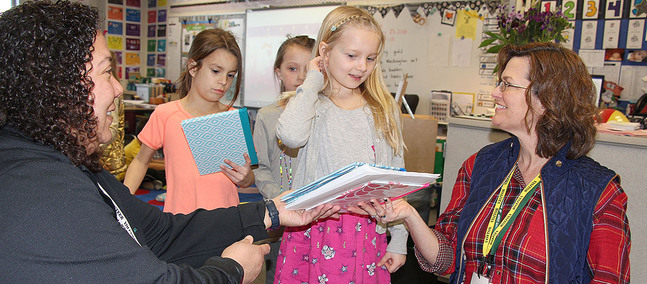Publishers encourage young authors
Posted on: Mar 15, 2018

At some point most young students probably wonder what it is like to be an author. The Tiger Publishing Center at Delano Elementary School gives them an opportunity to find out.
The publishing center is a volunteer service that helps students create their own books. Students write their own stories and provide the illustrations, while volunteers Cynthia Jacobson and Shadow Felknor take care of the book assembly.
This year is Jacobson’s sixth working with the publishing center, and Felknor’s fifth. Both have continued volunteering at the publishing center even though their children have outgrown the elementary.
“We’ve stayed because we like to see the kids at the elementary level grow,” said Jacobson. “You can watch the progression of how they improve from first grade to fourth grade, and when we go to hand out these books the kids are excited. It gives them something they’ve created themselves.”
“I love to see the creativity each one brings,” said Felknor. “I have had fun watching the younger siblings of my son’s classmates grow. I look back at Logan’s books and hope each parent feels the same joy I do as they look at them.”
Publishing process
The publishing process begins when a student writes their own story or works together with friends. The hand-written manuscript is dropped off at the “in bin” in the elementary media center along with an “author’s directions” form specifying choices of book cover and binding design. Students also fill out a “meet the author” page that is included with the book.
From there, Jacobson and Felknor pick up the manuscripts and take them home to type them.
The typed pages that leave room for illustrations are returned to the student, who notes any corrections that might be needed. Jacobson and Felknor make the corrections, and the student has the chance to draw their illustrations.
When the text is finalized and the illustrations done, Jacobson and Felknor create a book cover from cardboard, contact paper and gaffer tape. The pages are covered with Bristol board and sewn together with dental floss. Why floss?
“It’s sticky, it’s flat, it’s really hard to break, and it will last,” said Jacobson.
Finally, the book is glued into the cover with rubber cement, and after it dries the books are presented to the students in their classrooms.
“We like to deliver, because then we get the personal contact with the student,” said Jacobson.
Value
Jacobson and Felknor agreed that the writing process was important for students to explore and enjoy.
“Kids aren’t writing the way they used to before the computer age,” said Jacobson. “When you are a good reader you become a better writer, but it’s when you become a good writer that you become a much better reader. They go hand in hand, but if you become a good reader and all you do is read, that doesn’t necessarily make you a good writer without practice.”